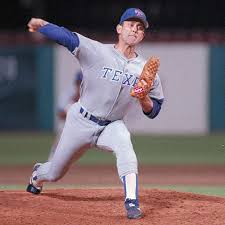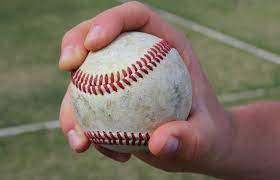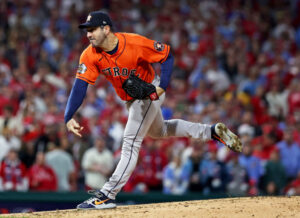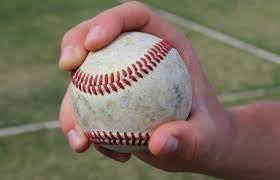Pitching in baseball is a complex and crucial skill that requires a combination of strength, speed, accuracy, and strategy. The mechanics of pitching involve a series of steps and movements that, when executed properly, can lead to success on the mound. The first step in the mechanics of pitching is the windup. This is the preparatory phase in which the pitcher aligns their body and gathers momentum for the pitch. The windup begins with the pitcher standing on the rubber, which is the rectangular piece of white rubber at the center of the pitcher’s mound. From this position, the pitcher will lift their lead foot and bring it back behind their body while simultaneously raising their throwing hand above their head. As the pitcher brings their lead foot back, they will also shift their weight onto their back leg. This weight shift helps to generate power and momentum for the pitch. At the same time, the pitcher will begin to rotate their hips, bringing their throwing arm back and across their body. This rotation helps to generate additional torque, which will be transferred to the ball during the delivery.

Once the pitcher has gathered momentum, they will begin the delivery phase of the pitching mechanics. During the delivery, the pitcher will transfer the energy generated during the windup into the pitch. This is done by pushing off the back leg, rotating the hips and shoulders, and extending the throwing arm toward the plate. As the throwing arm extends, the pitcher will release the ball from their hand. The release is a crucial moment in the mechanics of pitching, as it determines the trajectory, spin, and velocity of the pitch. A good release will result in a pitch that is difficult for the hitter to read and hit. After releasing the ball, the pitcher will follow through with their throwing arm. The follow-through is a continuation of the delivery, and it helps to ensure that the pitcher maintains their balance and control after releasing the ball. A good follow-through will also help to prevent injuries to the elbow and shoulder. In addition to the windup, delivery, and follow-through, there are several other important components of the mechanics of pitching. For example, the pitcher’s grip on the ball can have a significant impact on the pitch. Different grips can be used to produce different types of pitches, such as fastballs, curveballs, and sliders.

Of all of the varieties of pitches, fastballs are the most common. There are two common grips for a fastball, each with many benefits and drawbacks. While both pitches are thrown with the intention of producing maximum velocity and making it difficult for the hitter to hit, there are some key differences between the two pitches. One of the main differences between a two-seam fastball and a four-seam fastball is the grip. To throw a two-seam fastball, the pitcher places their index and middle fingers along the two seams of the baseball, with the thumb underneath. This grip allows the pitcher to generate movement on the pitch by manipulating the spin of the ball, specifically generating backspin. In contrast, to throw a four-seam fastball, the pitcher places their index and middle fingers perpendicular across two seams of the baseball, with the thumb underneath. This grip allows the pitcher to generate maximum velocity on the pitch by maximizing the amount of backspin. Another difference between a two-seam fastball and a four-seam fastball is the movement of the pitch.

A two-seam fastball is typically thrown with more movement than a four-seam fastball. This movement is created by the spin of the ball, which typically has less backspin, and is tilted more diagonally on its axis. In contrast, a four-seam fastball is typically thrown with less movement than a two-seam fastball. This is because the grip used to throw a four-seam fastball creates more backspin, while a two-seam has slightly off center backspin resulting in a pitch that is more straight and predictable. A third difference between a two-seam fastball and a four-seam fastball is the location of the pitch. Because of the movement and spin on the ball, a two-seam fastball is typically more difficult to control and can end up in unexpected places. This can make it more challenging for the pitcher to locate the pitch in the strike zone.
In contrast, a four-seam fastball is typically easier to control and can be thrown with greater accuracy. Personally, I throw a four seam fastball for the Jesuit baseball team, because I find that I can throw it harder and it is easier to control, however both types of fastball are very effective and used in the MLB, the highest level of baseball. One reason that fastballs are usually the most effective and common pitch is a phenomenon called the Magnus effect. It occurs when a spinning object moves through a fluid, such as air. As the object spins, it creates a swirling flow of fluid around it. This swirling flow creates a pressure difference on the two sides of the object, which produces a force that acts perpendicular to the direction of motion.This deviation is called the Magnus force, and it can cause the ball to break in a particular direction, such as to the left or right. The amount of Magnus force on a pitched ball depends on several factors, including the speed and direction of the ball, the amount of spin on the ball, and the density of the fluid through which the ball is moving. A pitched ball with a high amount of spin and a high speed will experience a larger Magnus force than a ball with less spin and a lower speed. In baseball, pitchers can use the Magnus effect to their advantage by changing the spin and speed of the ball. For example, a pitcher might throw a fastball with a four-seam grip, creating a tight, upward spin on the ball. This spin will cause the ball to experience a Magnus force that makes it rise as it travels through the air, making it difficult for the hitter to hit.
On the other hand, a pitcher might throw a curveball with a two-seam grip, which will create a more vertical spin on the ball. This spin will cause the ball to experience a Magnus force that makes it break in a particular direction, such as to the left or right. This can make it difficult for the hitter to predict the trajectory and movement of the ball, making it more challenging to hit.

Another essential type of pitch is the curveball. Pitchers often use this pitch to surprise batters and throw them off balance, making it difficult for them to hit the ball.
The key to throwing a good curveball is to grip the ball with the index and middle fingers placed along one seam of the ball while the thumb provides support from underneath. The pitcher then uses a sweeping motion with their arm to release the ball, putting a downward spin on it that causes it to drop or curve as it reaches the hitter. One of the reasons that curveballs are so effective is that they are difficult for batters to predict. Because the ball is spinning, it creates an optical illusion that makes it look like it is traveling in a straight line, only to break or curve at the last moment. This can cause the batter to swing at the wrong time or in the wrong direction, resulting in a strike or an easy out for the fielding team. In addition to their deceptive nature, curveballs are also effective because they can be thrown at various speeds and with different levels of break. A slow curveball will break gradually and can be used to tempt the batter into swinging early, while a hard curveball will break sharply and can be used to catch the batter off guard. This variety makes it difficult for batters to adjust to a pitcher’s curveball and can give the pitcher a significant advantage in a game. Curveballs are an extremely important weapon in a pitcher’s arsenal, because the reduced speed compared to a typical fastball and the deviation in movement compared to a fastball throws off the batter, making it very difficult to hit.

The pitcher’s arm angle is also an important factor in the mechanics of pitching. A lower arm angle can produce pitches with more downward movement, while a higher arm angle can produce pitches with more upward movement. The arm angle can also affect the amount of spin on the ball, which can impact the movement and break of the pitch. The most common arm angle is completely overhand, in which the pitcher releases the ball in a fully downward motion towards the plate. This is the technique that I personally use, because I find that my pitches have more velocity using this mechanic. However, many pitchers throw from other arm angles, such as a three quarters arm angle or sidearm. The three-quarters arm angle is similar to the overhand throw, but the pitcher’s arm is slightly bent at the elbow, causing the ball to be released at a slightly downward angle. The sidearm throw is when the pitcher brings the ball down to their side and releases it with a motion that is almost horizontal to the ground. Generally, the higher the arm angle, the faster the velocity of the pitch, but the less movement on the pitch itself. The lower the arm angle, the velocity is lower, but the ball will move horizontally as it travels to its target. Ultimately, the pitcher’s arm angle is entirely based off of what feels comfortable, as this is the key to pitching successfully.

In addition to these physical components, the mental aspect of pitching is also crucial. The mental aspect of pitching in baseball is an often-overlooked but crucial component of success on the mound. Pitching requires a combination of physical skill and mental toughness, as pitchers must be able to read the hitter, make quick, strategic decisions, and execute pitches under pressure. One of the key mental skills for pitchers is the ability to read the hitter. This involves not only understanding the hitter’s tendencies and weaknesses, but also being able to anticipate what they might do in a given situation. For example, a pitcher might notice that a certain hitter struggles with pitches on the outer half of the plate, and use that knowledge to their advantage by throwing pitches in that area. In addition to reading the hitter, pitchers must also be able to make quick, strategic decisions about which pitches to throw in different situations. This requires a combination of knowledge, experience, and instincts. A pitcher must be able to think on their feet and come up with a plan of attack based on the situation at hand.

Pitching also requires mental toughness and the ability to execute pitches under pressure. This means being able to stay focused and composed in high-pressure situations, such as with runners on base or in a close game. It also means being able to bounce back from mistakes and setbacks, and maintain a positive attitude even when things are not going well. Another important mental aspect of pitching is the ability to stay mentally sharp and focused throughout the game. Pitchers must be able to maintain their concentration and focus for the duration of the game, even when they are not on the mound. This can be challenging, as pitchers may have long stretches of time between innings when they are not actively involved in the game. In addition to these mental skills, pitchers must also be able to handle the mental demands of the game. This includes dealing with the expectations and pressure of playing professional baseball, as well as the mental and emotional challenges that come with performing in front of large crowds. Pitchers must be able to stay focused and composed in these situations in order to be successful.
Overall, the mechanics of pitching in baseball are complex and require a high level of skill and expertise. A pitcher must be able to coordinate their body movements and generate power and accuracy with their throwing arm. By mastering the windup, delivery, and follow-through, as well as other key components such as grip and arm angle, a pitcher can become a valuable asset to their team.
This article was created by writer Wallace Archie.
Stay tuned to the Roundup for more sports new and information.






